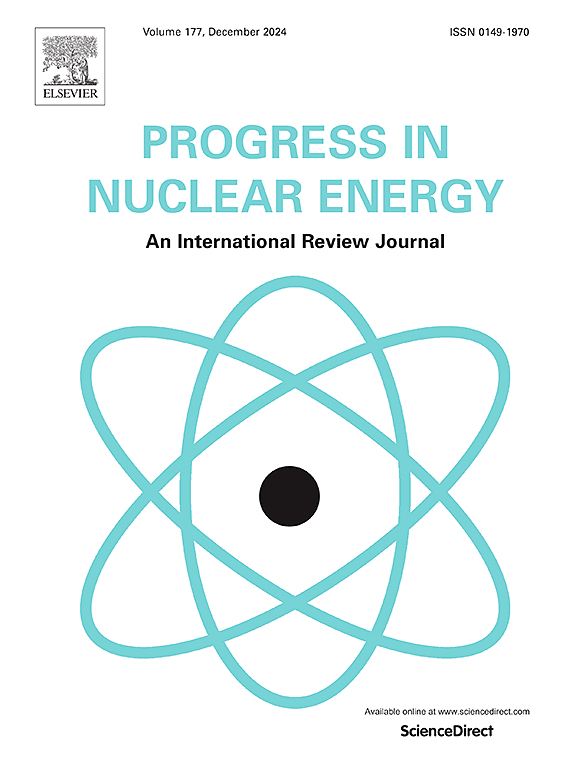Effect of Al2O3, RHF, and RHA on gamma shielding and mechanical properties of TeO2-Based glass using Phy-X/PSD
IF 3.3
3区 工程技术
Q1 NUCLEAR SCIENCE & TECHNOLOGY
引用次数: 0
Abstract
Radiation attenuation behaviour of TeO2–ZnO–Bi2O3–Na2O–Er2O3 with the addition of Al2O3 nanoparticles (NP), rice husk fibre (RHF), and rice husk ash (RHA) was investigated using Phy-X/PSD software. The mass attenuation coefficients of the chosen glasses were measured from 0.015 to 3 MeV. The results showed that increasing the RHF concentration of the glasses or decreasing the Al2O3 component of the glass system enhances the mass attenuation coefficient of the material. At low energy, there is a significant difference between the mass attenuation coefficients values of the samples with the lowest and highest Al2O3 content, where the difference is 0.05118 cm2/g at 0.015 MeV. TZNERHF had higher mass attenuation coefficients (0.05402 cm2/g), and TZNETiAl8 had the highest mass attenuation coefficients, with a value of 0.05357 cm2/g at 1.173 MeV. The results showed a decreasing trend in the half-value layer (HVL), tenth value layer (TVL), and mean free path (MFP) when the density increased from 5.12555 to 5.23882 g/cm3 and attenuation ability improved. Subsequently, the influence of Al2O3 on Zeff values became more considerable as Zeff values increased. The shielding qualities of their glass samples are also superior to commercial window glass and common shielding concrete. Thus, the glass samples can be used with excellent advantage as radiation shielding materials. The findings showed that adding RHF and lower Al2O3 enhanced the studied samples' radiation shielding properties. The results show that the TZNERHF glass sample has the highest mechanical properties. Thus, the TZNERHF sample is better than the other glass samples.
Al2O3、RHF和RHA对Phy-X/PSD teo2基玻璃屏蔽和力学性能的影响
采用Phy-X/PSD软件研究了Al2O3纳米颗粒(NP)、稻壳纤维(RHF)和稻壳灰(RHA)对teo2 - zno - bi2o3 - na20 - er2o3的辐射衰减行为。所选玻璃的质量衰减系数在0.015 ~ 3mev之间。结果表明,增加玻璃的RHF浓度或降低玻璃体系中Al2O3的含量均能提高材料的质量衰减系数。低能时,Al2O3含量最低和最高样品的质量衰减系数值存在显著差异,在0.015 MeV时,差异为0.05118 cm2/g。TZNERHF的质量衰减系数较高(0.05402 cm2/g),而TZNETiAl8的质量衰减系数最高,在1.173 MeV时达到0.05357 cm2/g。结果表明,当密度从5.12555 g/cm3增加到5.23882 g/cm3时,半值层(HVL)、十值层(TVL)和平均自由程(MFP)呈下降趋势,衰减能力增强;随后,随着Zeff值的增大,Al2O3对Zeff值的影响越来越大。其玻璃样品的屏蔽性能也优于商品窗玻璃和普通屏蔽混凝土。因此,玻璃样品可以作为辐射屏蔽材料使用,具有优异的优势。结果表明,添加RHF和低浓度Al2O3可提高样品的辐射屏蔽性能。结果表明,TZNERHF玻璃样品具有最高的力学性能。因此,TZNERHF样品优于其他玻璃样品。
本文章由计算机程序翻译,如有差异,请以英文原文为准。
求助全文
约1分钟内获得全文
求助全文
来源期刊

Progress in Nuclear Energy
工程技术-核科学技术
CiteScore
5.30
自引率
14.80%
发文量
331
审稿时长
3.5 months
期刊介绍:
Progress in Nuclear Energy is an international review journal covering all aspects of nuclear science and engineering. In keeping with the maturity of nuclear power, articles on safety, siting and environmental problems are encouraged, as are those associated with economics and fuel management. However, basic physics and engineering will remain an important aspect of the editorial policy. Articles published are either of a review nature or present new material in more depth. They are aimed at researchers and technically-oriented managers working in the nuclear energy field.
Please note the following:
1) PNE seeks high quality research papers which are medium to long in length. Short research papers should be submitted to the journal Annals in Nuclear Energy.
2) PNE reserves the right to reject papers which are based solely on routine application of computer codes used to produce reactor designs or explain existing reactor phenomena. Such papers, although worthy, are best left as laboratory reports whereas Progress in Nuclear Energy seeks papers of originality, which are archival in nature, in the fields of mathematical and experimental nuclear technology, including fission, fusion (blanket physics, radiation damage), safety, materials aspects, economics, etc.
3) Review papers, which may occasionally be invited, are particularly sought by the journal in these fields.
 求助内容:
求助内容: 应助结果提醒方式:
应助结果提醒方式:


